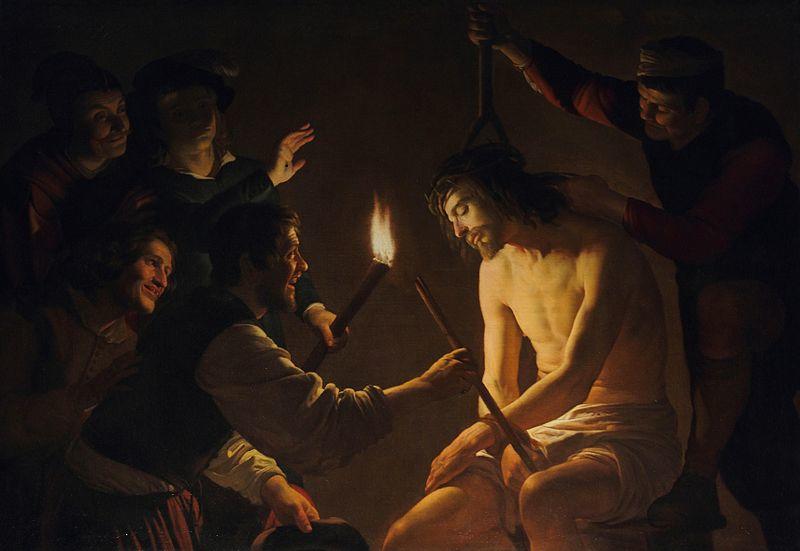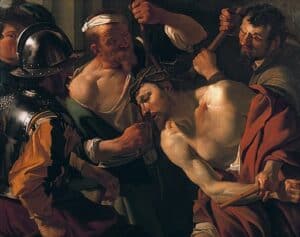Crowning with Thorns
Third Sorrowful Mystery of the Rosary

Introduction
The Crowning with Thorns, the Third Sorrowful Mystery of the Rosary, holds profound importance in Christian theology, representing the mockery and humiliation endured by Jesus on His journey to the Cross.
The significance of this sorrowful mystery lies in the cruel symbolism of the crown of thorns. Placed upon Jesus’ head, it serves as a twisted coronation, intended to mock His claim as the King of Kings. The thorns, piercing His sacred brow, symbolize the weight of sin and the consequences of human rebellion against God.
Moreover, the Crowning with Thorns emphasizes the contrast between the divine kingship of Jesus and the earthly powers that sought to demean Him. The soldiers’ cruel acts highlight the depth of Jesus’ humiliation and His willingness to endure such degradation for the sake of humanity’s redemption.
In contemplating this sorrowful mystery, believers are called to reflect on the paradox of Christ’s kingship—a kingship founded on love, humility, and the acceptance of suffering. It serves as a poignant reminder of the price Jesus paid for our salvation and the transformative power of His sacrificial love. The Crowning with Thorns invites believers to recognize the dignity inherent in embracing the way of the Cross, challenging them to find strength and purpose in moments of mockery and humiliation.
Scriptures of the Crowning with Thorns
Matthew 27:27-31
Then the soldiers of the governor taking Jesus into the hall, gathered together unto him the whole band; And stripping him, they put a scarlet cloak about him. And platting a crown of thorns, they put it upon his head, and a reed in his right hand. And bowing the knee before him, they mocked him, saying: Hail, king of the Jews. And spitting upon him, they took the reed, and struck his head. And after they had mocked him, they took off the cloak from him, and put on him his own garments, and led him away to crucify him.
Scripture Commentary
Matthew 27:27-31 recounts a significant episode in the biblical narrative, capturing the events leading up to the crucifixion of Jesus Christ. This passage is situated within the larger context of the Gospel of Matthew, focusing on the culmination of Jesus’ earthly ministry and the fulfillment of prophecies regarding the Messiah.
In these verses, the scene unfolds as Jesus, having been condemned to death, is handed over to the Roman soldiers for execution. The Roman governor, Pontius Pilate, delivers Jesus into the hands of the soldiers, who then take Him into the Praetorium, the Roman governor’s residence. What follows is a sequence of events that exemplify the brutality and mockery inflicted upon Jesus before His crucifixion.
The soldiers, aware of Jesus’ claim to be the King of the Jews, decide to mockingly play along with this assertion. They dress Him in a scarlet robe, symbolizing royalty, and fashion a crown of thorns, which they place on His head. The soldiers proceed to jeer at Jesus, bowing down before Him in a sarcastic display of mock homage. The verbal and physical abuse intensifies as they spit on Him and strike Him on the head with a reed, a cruel gesture meant to further degrade and humiliate Him.
This episode holds profound theological significance, reflecting themes of suffering, mockery, and the sacrificial nature of Jesus’ mission. The scarlet robe and crown of thorns, elements associated with kingship, serve as ironic symbols of the divine paradox that Jesus, the true King, willingly endures such indignity for the sake of humanity’s redemption.

The use of thorns in particular harkens back to the biblical narrative in Genesis, where thorns are a consequence of the fall of humanity. In this context, the crown of thorns represents not only the physical pain inflicted on Jesus but also the weight of humanity’s sin that He willingly bears.
Moreover, the soldiers’ actions highlight the contrast between earthly perceptions of power and the divine reality embodied in Jesus. While the soldiers mock Him as a powerless king, Jesus, in His submission to this mistreatment, is paradoxically exercising the ultimate authority over sin and death.
As we reflect on Matthew 27:27-31, we are confronted with the depth of Christ’s love and sacrifice. The mockery and abuse He endured serve as a poignant reminder of the lengths to which God was willing to go in order to reconcile humanity to Himself. This passage foreshadows the ultimate act of redemption – the crucifixion – where Jesus, the Lamb of God, takes upon Himself the sins of the world, offering salvation to all who believe in Him.
Download our Sorrowful Mysteries pdf Document
We have a Sorrowful Mysteries pdf available for your use. It is free to download and share. It can be printed and used for praying the Rosary and is an excellent aid for anyone, especially for beginners. The author still uses it to this day.
To view our Sorrowful Mysteries pdf page, click the link. To go straight to the pdf, click the button below.

We strive to provide the most complete and highest quality material we can for you, our readers. Although not perfect,
it is our desire and prayer that you benefit from our efforts.
Last Publish: January 27, 2024

